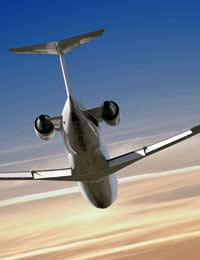How Do Aircraft Fly?

Have you ever held your hand out of the window of a fast-moving car? If so, you may have found that by holding your palm level with the ground the air slips over it without much effect. However, if you angle your palm slightly upwards, at a certain angle your hand will push up and you have to exert a little downwards force to keep it at the same height.
How Newton's Law Helps
Well, this is Newton’s 3rd Law at work; to every action there is always an equal and opposite action. The angle of your palm creates a deflection of air downwards and, according to Newton, the downward force is equalled by an upward movement of your hand. In the case of an aircraft, wings are always designed at a slight angle so that air is deflected downwards, resulting in upwards ‘lift’.However, that is not the whole story. In fact, it is still hotly debated as to the amount of lift that an aircraft wing actually gets from the Newton phenomenon. The other force that causes the wing to rise is something called the Bernoulli Principle.
.
The Wing’s Shape
Have you ever noticed that the top surface of an aircraft wing is more rounded than the underside? The top surface is curved so that air flowing over it speeds up, while the pressure around the faster flowing air actually decreases – Bernoulli’s discovery. Air moving over the top of the wing is faster than air moving underneath, resulting in a pressure difference; lower pressure on top and higher pressure on the bottom. Anything in the way of this pressure difference, e.g. the wing, will be lifted upwards, from the high pressure zone to the lower pressure zone.The clever design of the airfoil shape of the wing means that it can utilise both of the forces described above, air deflection and air speed over the top and bottom surfaces of the wing, to create an upward movement.
How Do Pilots Control Lift?
Having read the above descriptions about lift, one might think that these forces are uncontrollable. Of course, this is not the case. Aircraft designers and pilots use these forces to their advantage, to gain height on take-off and to increase altitude during flight. But these can be completely controlled. For example, suppose an aircraft needs to descend either during flight or for landing. How do these upward forces stop working on the wings? Well, in fact they don’t stop working – no one can ‘turn off’ physical phenomenon. But we can overcome those forces.Elevators Go Up and Down
There are small hinged surfaces on the tail wings of aircraft, called elevators. Downward elevators increase the amount of deflection of air downwards (remember Newton’s Law), so there is more lift created on the tail. More lift on the tail means it is pushed upwards and correspondingly the nose of the aircraft dips.The same principle applies to turning the aircraft. Ailerons are fitted on each wing. These are similar to the elevators described above, but the difference is that they work in pairs. If the pilot wants to turn left, he moves the control yoke to the left, which causes the left wing aileron to go up and the right aileron to go down. Since the right wing aileron is down, more air is deflected downwards on that wing, thereby pushing it upwards – the aircraft rolls to the left.
Full Control Over Physics
The simple concepts of pressure differences over the top and bottom surfaces of wings, combined with the air deflection principle, offer pilots total control over movement upwards, downwards, left and right. This is a great example where nature, science and engineering have come together to provide us with complete control, even in the strongest of air currents.- How Many Planes Are There in the Sky?
- Environmental Facts About the Air Travel Industry
- Why Aircraft Engines Don't Fail
- How Pilots Train for all Possible Scenarios
- Aircraft: What are all the Checks For?
- What Keeps Such a Heavy Machine in the Air?
- What Are Those Noises Inside the Aircraft?
- Why is Turbulence Not Usually Dangerous?
- Doors to Automatic: What is That all About?


Re: Why Some People Have a Fear of Flying
A hydrofoil with a hull Is primitive, rather dull; Must not it sink Should engines kink? Airplanes crash and crack…
Re: Aerophobia Clinics and Courses
I am absolutely petrified of flying however I have agreed to fly in July to Spain. I am flying with my two young children, both…
Re: Anxiety Medication
Please help I'm absolutely terrified of flying and I go away in two wks , I really don't know how I'm going to cope I have tryed diazepam in…
Re: What Causes The Fear of Flying?
My 13 year old daughter is now so afraid of flying that we were unable to go on our last holiday in March. We arrived at the…
Re: How I Overcame My Fear of Flying: A Case Study
At Southport we were flying to Ostend in a Bristol44 aircraft It taxied along the runway ,just before…
Re: Doors to Automatic: What is That all About?
Very good I've always wondered what Doors to automatic and cross check means
Re: What is Aerophobia?
i dont have aerophobia but sky phobia…
Re: Hypnosis and Fear of Flying
The difficulty with phobias is that there are often underlying problems so that one phobia reveals another and so on. General…
Re: Why is Turbulence Not Usually Dangerous?
hi, i love flying but get really scared during turbulence…strange question but if you were looking at a plane that…
Re: Why Some People Have a Fear of Flying
I am terrified of flying... Over the sea especially :-(. We fe flying from London to Lisbon. So over the bay of…